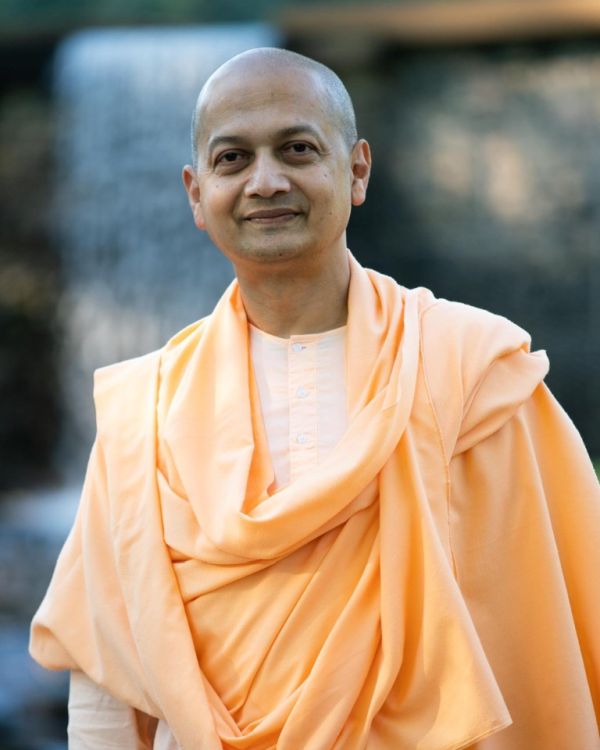
Resident Minister of
The Vedanta Society of New York
The Vedanta Society of New York has been the home of some of the most illustrious monks of the Ramakrishna Order, starting with Swami Vivekananda to the present-day Swami Sarvapriyananda.
Swami Sarvapriyananda has been the Minister and spiritual leader of the Vedanta Society of New York since January 2017. He joined the Ramakrishna Math in 1994 and received sannyasa in 2004. He served as an acharya (teacher) of the monastic probationers’ training center at Belur Math, India. He also served in various capacities in different educational institutes of the Ramakrishna Mission in India and as the Assistant Minister of the Vedanta Society of Southern California.
During 2019-2020 he was a Nagral Fellow at the Harvard Divinity School.
Swami Sarvapriyananda is a well-known speaker on Vedanta and his talks are extremely popular globally via the internet. He has been a speaker on various prestigious forums such as TEDx, SAND, Google Talk etc. He has also been invited to speak at several universities across the world, including Harvard University. The swami has engaged in dialogue with many eminent thinkers such as Deepak Chopra, Rupert Spira, Rick Archer, David Chalmers and Sam Harris.
He has played a prominent role in organizing and participating in various interfaith panels and seminars, including speaking at the World Parliament of Religions in Toronto in 2018, and at the United Nations Headquarters in New York.
Some of Swami Sarvapriyananda’s popular talks have been compiled into e-books - “Who am I?”, “What is Vedanta?” and “Dissolve into Infinity” are currently available on Amazon Kindle.
Website Vedanta Society of New York click here
Podcasts
The Four Yogas (6): The four Yogas, as described in Hindu philosophy, are Karma Yoga, Bhakti Yoga, Jnana Yoga, and Raja Yoga. Karma Yoga emphasizes selfless action and detachment from the results of one's actions. Bhakti Yoga focuses on devotion and worship of a personal God or divine principle. Jnana Yoga emphasizes the attainment of knowledge and understanding through self-inquiry and contemplation. Raja Yoga, also known as Ashtanga Yoga, involves the practice of physical postures, breathing exercises, and meditation to achieve union with the divine.
Advaita Vedanta (6): Advaita Vedanta is a school of Hindu philosophy that teaches non-dualism and asserts that the true nature of the self (Atman) and the ultimate reality (Brahman) are identical. It emphasizes the importance of spiritual practice, such as meditation and self-inquiry, to realize this truth and attain liberation from the cycle of birth and death.
Practical Vedanta (6): Practical Vedanta, is a path of selfless action that emphasizes the importance of performing one's duties without attachment to the results. Practical Vedanta is based on the teachings of the Bhagavad Gita and is often integrated into daily life through practices such as meditation, prayer, and service to others.
Harmony of Religions (3): The harmony of religions is the idea that all religions share a common spiritual essence and that there are multiple paths to the ultimate reality or God. The promotion of harmony among different religions can help to foster mutual respect, tolerance, and understanding, and contribute to a more peaceful and compassionate world.
Divine Personalities (5)
Lectures on Scriptures
Vedantasara (37): While not discarding faith in any religion, Vedanta rests ultimately on the light of reason, or Buddhi, giving it a natural appeal to rationally inclined people the world over. 'Vedantasara' is one of the best known examples of the philosophy of the Upanisads as taught by Sankaracarya. It is truly the essence of Vedanta.
Bhagavad Gita (160 - Ongoing): The Shrimad Bhagavad Gita, often referred to as the Gita, is a 700-verse Hindu scripture that is part of the epic Mahabharata, dated to the second half of the first millennium BCE and is is considered to be one of the holy scriptures for Hinduism. Lectures uploaded weekly to the collection.
Katha Upanishad (44): The scripture concerns the story of a young man who goes to the house of death to find out what happens after death. The reply describes the nature of reality and the meaning of life. This scripture is one of the most popular Upanishads. Lectures uploaded weekly to the collection.
Gospel of Sri Ramakrishna (30): The Gospel of Sri Ramakrishna as translated by Swami Nikhilananda offers the reader a penetrating view into the spiritual wisdom of India. On account of his deep mystical experiences and constant absorption in God, Sri Ramakrishna (1836 - 1886) is regarded as being of the stature of Krishna, Buddha, and Christ.

